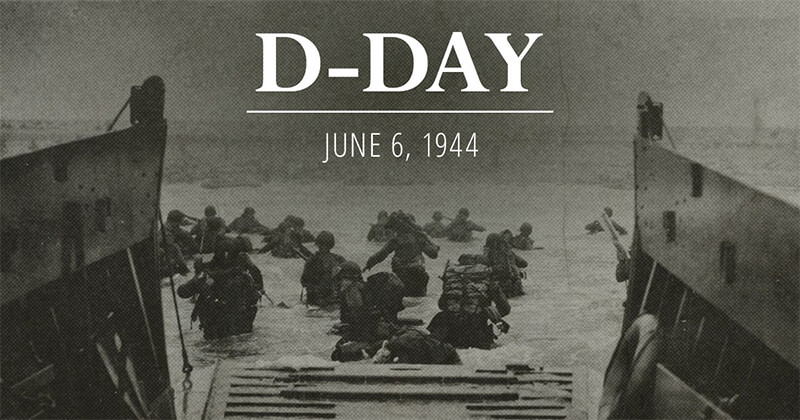
Patcnews June 6, 2014 Reports The 70th Anniversary of D-Day June 6, 1944
History Stories
D-Day: Facts on the Epic 1944 Invasion That Changed the Course of WWII
The Allied invasion of Normandy was among the largest military operations ever staged. Learn how many fighting forces took part, why it was called D-Day, stats on its planning, execution and more.
Dave Roos
Updated:
Jun 3, 2022
June 6, 1944 D-Day
Without the brilliant planning and heroic sacrifices of the D-Day invasion, the Allies may have never defeated the Nazi forces in Europe. On June 6, 1944, more than 156,000 American, British and Canadian troops stormed 50 miles of Normandy's fiercely defended beaches in northern France in an operation that proved to be a critical turning point in World War II. Below are key facts on the planning and execution of the epic Allied invasion.
1. D-Day Meaning: The 'D' in D-Day doesn’t actually stand for anything. Unlike V-E Day (“Victory in Europe”) or V-J Day (“Victory over Japan”), the “D” in D-Day isn’t short for “departure” or “decision.” As early as World War I, the U.S. military used the term D-Day to designate the launch date of a mission. One reason was to keep the actual date out of the hands of spies; another was to serve as a placeholder until an actual date was chosen. They also used H-Hour for the specific time of the launch.
President Franklin D. Roosevelt and Prime Minister Winston Churchill orchestrated the D-Day plans. President Franklin D. Roosevelt and Prime Minister Winston Churchill orchestrated the D-Day plans.
2. The D-Day invasion took years of planning. Allied leaders Franklin Roosevelt and Winston Churchill knew from the start of the war that a massive invasion of mainland Europe would be critical to relieve pressure from the Soviet army fighting the Nazis in the east. Initially, a plan called “Operation Sledgehammer” called for an Allied invasion of ports in northwest France as early as 1943, but Roosevelt and Churchill decided to invade Northern Africa first and attack Europe’s “soft underbelly” through Italy.
3. D-Day was the largest amphibious invasion in military history. According to the D-Day Center, the invasion, officially called "Operation Overlord," combined the forces of 156,115 U.S., British and Canadian troops, 6,939 ships and landing vessels, and 2,395 aircraft and 867 gliders that delivered airborne troops.
4. Allied forces carried out a massive deception campaign in advance of D-Day. The idea behind the ruse was to trick the Nazis into thinking that the invasion would occur at Pas-de-Calais, the closest French coastline to England. The Allies used fake radio transmissions, double agents, and even a “phantom army,” commanded by American General George Patton, to throw Germany off the scent.
D-Day Interactive on HISTORY.com
Explore how the battle unfolded in our interactive timeline of the day.
5. A D-Day dress rehearsal was a fiasco. Two months before D-Day, Allied forces conducted a disastrous dress rehearsal of the Normandy invasion on an evacuated English beach called Slapton Sands. Known as “Exercise Tiger,” 749 U.S. troops lost their lives after a fleet of German E-boats caught wind of the mock invasion and torpedoed American tank landing ships. Survivors described the Exercise Tiger fiasco as more terrifying than the D-Day landing on Omaha Beach.
Engineers of the 531st Engineer Shore Regiment explode a German landmine during the Allied invasion of France.
6. Germany had fortified France's coast. Anticipating an Allied invasion somewhere along the French coast, Adolf Hitler charged Field Marshal Erwin Rommel with fortifying Nazi defenses in France. In 1943, Rommel completed construction of the “Atlantic Wall,” Germany’s 2,400-mile line of bunkers, landmines and beach and water obstacles. It’s estimated that the Nazis planted 4 million landmines along Normandy’s beaches.
Ammunition stored in the town square of Moreton-in-Marsh, England in May 1944 in preparation for D-Day.
7. The U.S. shipped tons of supplies to the staging area in England. Since Operation Overlord was launched from England, the U.S. military had to ship 7 million tons of supplies to the staging area, including 450,000 tons of ammunition.
8. Bad weather delayed the invasion. Troops and supplies were in place by May, but bad weather delayed the launch date of the invasion. On June 5, General Dwight D. Eisenhower, the Supreme Allied Commander in charge of Operation Overlord, decided that the invasion would happen the next day, in part because the weather was still rough and Nazi planes were grounded. That same day, 1,000 British bombers dropped 5,000 tons of munitions on Nazi gun batteries along the Normandy coast to cripple Germany’s defenses before the imminent invasion. U.S. Army infantry men approaching Omaha Beach, Normandy, France on June 6, 1944.
9. D-Day was carried out along five sections of beachfront. Operation Overlord was divided among sections of beachfront along the Normandy coast codenamed, from West to East: “Utah,” “Omaha,” “Gold,” “Juno” and “Sword.”
General Dwight D. Eisenhower
Why Gen. Eisenhower Threatened to Quit Just Before D-Day
Erwin Rommel What Hitler Got Wrong About D-Day Omaha Beach 7 Surprising Facts About D-Day American paratroopers attached to the static line just prior to jumping during the invasion of Normandy, France.
10. Paratroopers launched the operation before dawn. The D-Day invasion began in the pre-dawn hours of June 6 with thousands of paratroopers landing inland on the Utah and Sword beaches in an attempt to cut off exits and destroy bridges to slow Nazi reinforcements. American paratroopers suffered high casualties at Utah beach, some drowning under heavy equipment in flooded marshland, others shot out of the sky by Nazi snipers. The British and Canadian paratroopers met less resistance at Sword beach and quickly took two key bridges.
11. More than 156,000 Allied ground troops stormed the beaches. In wave after wave of thousands of landing ships, more than 156,000 Allied infantrymen stormed the five beaches. Facing them were around 50,000 Germans troops. Stormy seas made the landings incredibly difficult, with many regiments coming ashore far from their target destinations. At Omaha Beach, only two of the 29 amphibious tanks even made it to land on their own power (three were later transported to the beach). At Utah Beach, the American troops included 14 Comanche “code-talkers” who relayed critical tactical messages in their Native American tongue.
Massive landing and deployment of U.S. troops, supplies and equipment day after victorious D-Day action on Omaha Beach, barrage balloons keep watch overhead for German aircraft while scores of ships unload men and materials.
Massive landing and deployment of U.S. troops, supplies and equipment day after victorious D-Day action on Omaha Beach, barrage balloons keep watch overhead for German aircraft while scores of ships unload men and materials.
12. The toughest fighting was on Omaha Beach. At Omaha Beach, bombing runs had failed to take out heavily fortified Nazi artillery positions. The first waves of American fighters were cut down in droves by German machine gun fire as they scrambled across the mine-riddled beach. But U.S. forces persisted through the day-long slog, pushing forward to a fortified seawall and then up steep bluffs to take out the Nazi artillery posts by nightfall. All told, around 2,400 American troops were killed, wounded or unaccounted for after the fighting at Omaha Beach.
13. Canadian troops at Juno Beach captured the most territory. Canadian soldiers also suffered terrible casualties at Juno Beach, battling rough seas before landing on a heavily defended strip of shoreline. Similar to the Americans at Omaha Beach, the first lines of Canadian troops were gunned down en masse by Nazi artillery—estimates put the initial casualty rate at 50 percent—before pushing beyond the beachfront and chasing the Germans inland. In the end, the Canadians at Juno captured more towns and territory than any other battalions in Operation Overlord.
14. All five beaches were secured by Allied forces by June 11. Five days after the D-Day invasion, troops immediately began installing two massive temporary harbors that had taken six months to construct back in England. All told, the Allies unloaded approximately 2,500,000 men, 500,000 vehicles and 4,000,000 tons of supplies at the temporary harbors over the remaining course of the war.
Wounded U.S. soldiers of the 3rd Battery, 16th Infantry Regiment, 1st US Infantry Division, lean against chalk cliffs while eating and smoking after storming Omaha Beach in Normandy on D-Day. Wounded U.S. soldiers of the 3rd Battery, 16th Infantry Regiment, 1st US Infantry Division, lean against chalk cliffs while eating and smoking after storming Omaha Beach in Normandy on D-Day.
15. The D-Day invasion marked a turning point in the war. The total Allied losses at Normandy are estimated to be at least 4,413. Total Allied casualties in the Battle of Normandy, which dragged on until August, topped 226,000. But thanks in part to the massive influx of troops and equipment, D-Day marked a decisive turning point in the war. Less than a year later, on May 7, 1945, Germany signed an unconditional surrender.
FACT CHECK: We strive for accuracy and fairness. But if you see something that doesn't look right, click here to contact us! HISTORY reviews and updates its content regularly to ensure it is complete and accurate.

